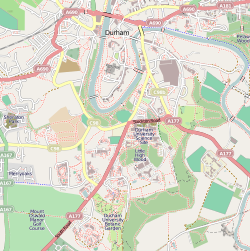St Margaret's Church, Durham
| St Margaret's, Durham | |
|---|---|
| St Margaret's Church, Durham | |

St Margaret's Church with Durham Cathedral in the background
|
|
| 54°46′33″N 1°34′48″W / 54.7758°N 1.5799°W | |
| Location | Crossgate, Durham, County Durham, DH1 4PR |
| Country | England |
| Denomination | Church of England |
| Previous denomination | Roman Catholic Church |
| Churchmanship | Liberal Catholic |
| Website | Church website |
| History | |
| Dedication | St Margaret of Antioch |
| Architecture | |
| Status | Active |
| Functional status | Parish Church |
| Heritage designation | Grade I listed |
| Designated | 6 May 1952 |
| Years built | 12th century |
| Administration | |
| Parish | St. Margaret Durham |
| Deanery | Durham |
| Archdeaconry | Archdeaconry of Durham |
| Diocese | Diocese of Durham |
| Clergy | |
| Rector | Fr Barnaby Huish |
St Margaret's Church Durham is an active parish Church situated on Crossgate in the city of Durham in the North-East of England. The building is Grade I listed and substantial parts date from the 12th century; the compact yet spacious interior has a pleasing asymmetry, which reveals different stages in the building's development.
St Margaret's was established in the 12th century as a Chapel of Ease in the Parish of St Oswald, to serve inhabitants of the Borough of Crossgate. Like St Oswald's, St Margaret's was under the jurisdiction of the Prior of Durham (whose successors, the Dean and Chapter, are to this day Patrons of the Living). There is evidence that, following the establishment of their own Chapelry, the people of Crossgate resented still having to attend the Parish Church at certain times, and still having to pay certain dues. One dispute in 1343 culminated in the Prior having the font removed from St Margaret's; only for it to be returned at the command of the Bishop (albeit with a warning which made it clear that the parishioners had no right to use it). It was not long afterwards, however, that residents of the Chapelry were granted the right to be married, churched and baptized in St Margaret's; and in 1431 the surrounding Church Garth was consecrated to allow the dead to be buried there.
The earliest extant parts of the building are estimated to date from around AD 1150. At this time, the church probably consisted of the Nave, South Aisle and Chancel. A North Aisle was added towards the end of the twelfth century; the North Nave arcade is taller and more elaborate than its South Nave counterpart (though both are in the Norman style). The aforementioned font is also still in place, and it too is believed to date from the twelfth century. Two Norman windows survive from this period: one in the Chancel, one in the South Nave clerestory. In the time of the fourteenth-century Bishop de Bury, the South Aisle was remodelled, and new clerestory windows were inserted above the Nave. Further expansion took place in the fifteenth century, including the addition of a Lady Chapel to the south of the Chancel, and the building of the tower. Two of the church's three bells date from this period (the other is sixteenth-century). In the second half of the nineteenth century, the Church was restored internally and externally; the North Aisle (as visible from the street) was largely rebuilt, and a full set of stained glass windows (judged to be of good quality for their time) were added.
...
Wikipedia

